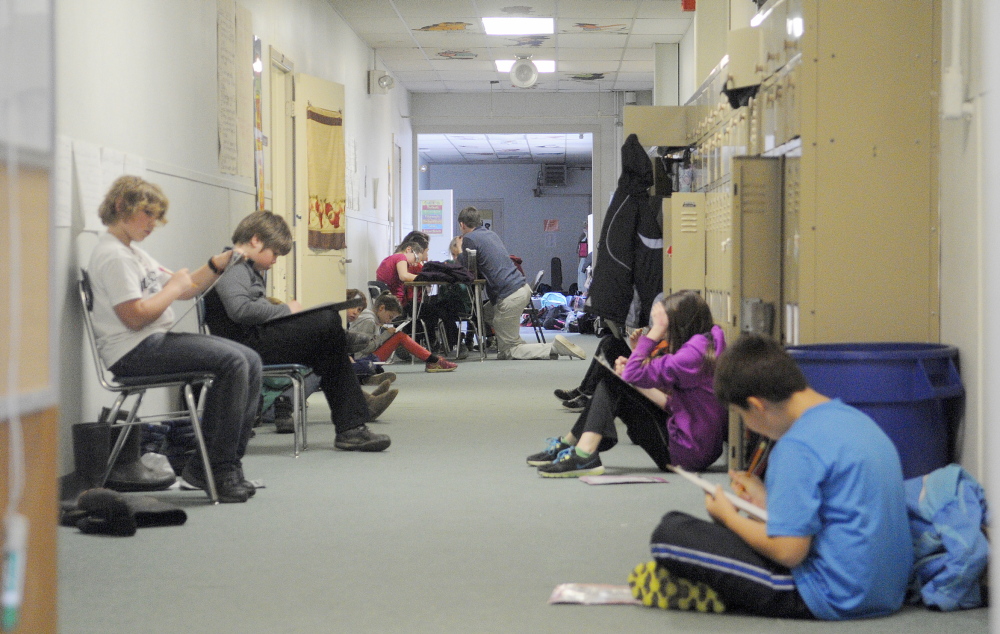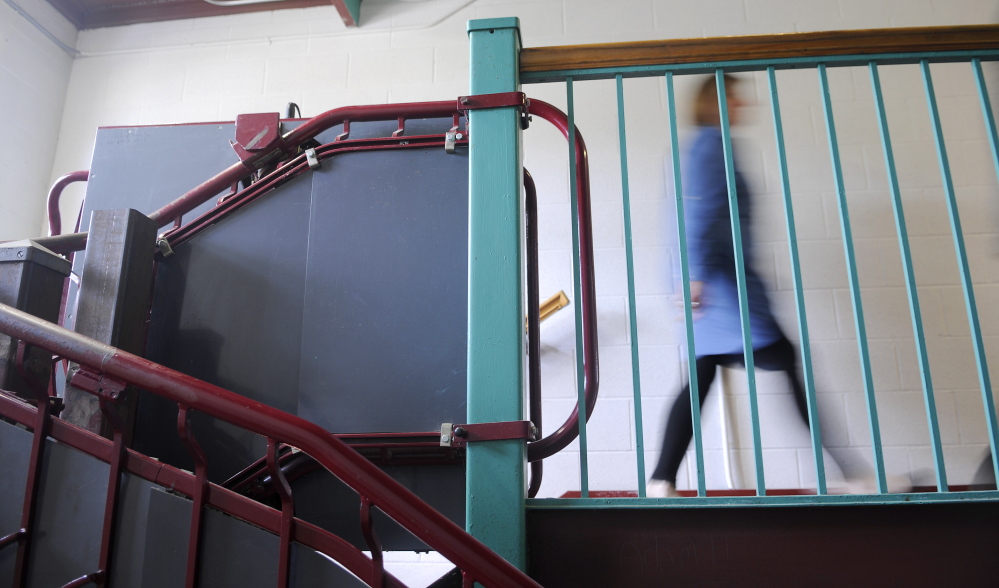MONMOUTH — Monmouth Middle School is one step closer to renovation or replacement, but it will likely be several years until students and staff are rid of the wheelchair lifts, the sloping floors connecting wings of different ages and the rooms with hardly any power outlets.
Still, officials in Regional School Unit 2 are glad to see the project moving forward in the state’s school construction pipeline. The State Board of Education has added Monmouth Middle School to a list of approved projects.
“We’re excited that they’ve made this decision,” Buildings and Grounds Director Gordon Murray said. “It’s a starting point to say that our buildings need to be addressed.”
Placement on the approved projects list means that the state has committed to funding a project. It does not indicate what type of construction work would be funded or when.
“It’s basically the beginning of a very long process,” said Scott Brown, director of school facilities at the Department of Education.
Brown said department staff will work this summer with RSU 2 and five other districts whose projects were approved to lay out the project design process, including things like when each district must present a concept for approval by the State Board of Education.
RSU 2 Superintendent Virgel Hammonds has recommended to the school board’s Finance Committee to include $150,000 in the 2014-15 budget for initial design work, which he said will be reimbursed by the state down the road.
RSU 2 has been making the most urgent improvements to Monmouth Middle School, such as replacing the gym floor last year because the old one was so uneven it was unsafe. But for a larger solution, there hasn’t been much for the district to do since submitting an application to the Major Capital School Construction Program in 2010.
Staff from Brown’s office visited schools and rated 71 applications based on the buildings and grounds, school population and the educational program. Projects receive points for unsafe conditions, inefficient mechanical systems, outdated instructional spaces, current or projected overcrowding, and other conditions.
Monmouth Middle School scored 135.6 out of 200 points, earning it the ninth spot on the state’s priority list.
The State Board of Education approved the top six projects for funding in 2012. Earlier this month, they added six more, including Monmouth Middle School.
Monmouth Middle School is a 55,000-square foot building that serves grades four through eight. It has been built in stages, starting with the old Monmouth Academy building from 1855 — which houses the library and may be preserved in some way — and ending with the wing that opened in 1989, when Monmouth Academy moved across the street.
The building presents maintenance, energy and instructional challenges, Murray said.
“We just don’t educate like we did back in 1950 or 1850,” he said.
The fact that the school was cobbled together over time is evident in its three boilers located in different sections of the building and the short staircases and ramps connecting wings that are less than a half-story higher or lower than one another.
There are problems with accessibility for people with disabilities. Instead of elevators, the building has wheelchair lifts for three large staircases, plus a smaller lift to help people onto the stage. Some bathrooms lack accessible stalls or doors that are wide enough for a wheelchair to pass through.
Signs of structural problems are evident from cracks and leaks in cinder block walls, particularly in the wing that houses grades four through six.
On Thursday, outside temperatures were only in the mid-40s, but windows were open in classrooms and hallways to keep the building from overheating. Deborah Emery, Monmouth’s principal for prekindergarten through sixth grade, said it’s difficult to focus on learning when students and teachers aren’t physically comfortable in a classroom.
“We’ve had to overcome issues around temperature,” she said. “You can’t get a consistent temperature in the rooms. Windows open, windows close.”
A teacher asked visitors to lower their voices in the hallway because her students were taking a test.
“It’s so hot I can’t shut the door,” she said.
In one wing, students were working in the hallway, sitting on the floor or on chairs they’d dragged out of classrooms. Emery said that’s not a frequent occurrence, but they need more flexible spaces for groups of different sizes now that teachers are working more in teams and students are collaborating on projects. Emery said one option that might work better is a “pod” system of classrooms clustered around a communal meeting space.
“We’re an innovative school district, and we would like to have a building that matches it,” she said.
Seventh and eighth graders encounter problems because there’s only one science lab in the building, and they have to cross the road to get to classes some of them take at Monmouth Academy.
Building a new school on the same side of the road as Monmouth Academy would fix the latter problem. Murray said the district will also explore the possibility of building a single school for prekindergarten through eighth grade because Cottrell Elementary School also has problems.
The state ranked Cottrell 56th on the priority list. The two Monmouth schools are the only ones on the list from RSU 2, which also includes Dresden, Farmingdale, Hallowell and Richmond.
In the past three cycles of school construction, two-thirds of the projects have been additions or renovations, while the remaining one-third have been the construction of new buildings, according to the Department of Education.
After being placed on the approved projects list, a project must receive the State Board of Education’s approval three more times: for the site, the concept and the design and funding. Local voters must agree to the project at a referendum before the school district can seek design and funding approval. The commissioner of education must sign off on final funding after bids come in.
Of the six schools added to the approved project list in January 2012, two have advanced so far, according to State Board of Education minutes. Morison Memorial School in Corinth received concept approval in November and Charles A. Snow received the same in March.
Susan McMillan — 621-5645smcmillan@centralmaine.comTwitter: @s_e_mcmillan
Send questions/comments to the editors.





Success. Please wait for the page to reload. If the page does not reload within 5 seconds, please refresh the page.
Enter your email and password to access comments.
Hi, to comment on stories you must . This profile is in addition to your subscription and website login.
Already have a commenting profile? .
Invalid username/password.
Please check your email to confirm and complete your registration.
Only subscribers are eligible to post comments. Please subscribe or login first for digital access. Here’s why.
Use the form below to reset your password. When you've submitted your account email, we will send an email with a reset code.